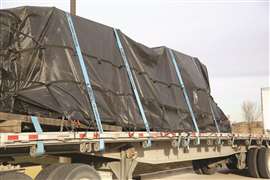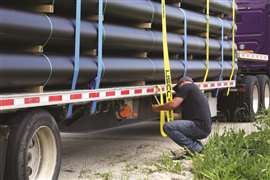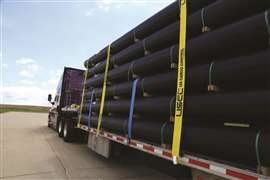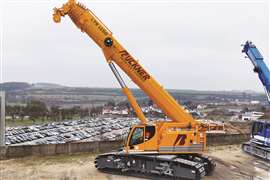What are the best methods for load securement?
28 June 2023
Cargo securement is among the top five out-of-service violations for heavy haulers, according to US Cargo Control’s Business Development Consultant Alex Ledger.
 A tie down is a combination of securing devices (webbing, chain, rope, binders, shackles, D-rings, etc.) that attaches cargo to, or restrains cargo on a vehicle, and is attached to an anchor point(s).
A tie down is a combination of securing devices (webbing, chain, rope, binders, shackles, D-rings, etc.) that attaches cargo to, or restrains cargo on a vehicle, and is attached to an anchor point(s).
“Improper or inadequate cargo securement accounted for 10.6 percent of vehicle out-of-service violations during last year’s Commercial Vehicle Safety Check’s International Roadcheck,” Ledger said. “Besides the risk of being placed out of service, there are many more serious consequences for improper cargo control securement, including citations and fines, damage to the vehicle, damage to the cargo, loss of the load, or even loss of life.”
Properly securing cargo loads is always worth the time and effort. It’s important to understand how tie downs should be used to ensure safe and legal cargo securement.
US Cargo Control sells a wide range of tie-down straps and hardware, chains and binders, winches and other supplies for heavy hauling. It also sells rigging gear for all sorts of specialized lifting and rigging, including lifting beams and spreader bars, wire rope, slings and rigging hardware. US Cargo Control helps its customers determine what they need to safely perform their work.
Defining a tie down
In the realm of heavy hauling, the Federal Motor Carrier Safety Administration (FMCSA) states that a tie down is a combination of securing devices (webbing, chain, rope, binders, shackles, D-rings, webbing ratchet, etc.) that forms an assembly that attaches cargo to, or restrains cargo on a vehicle, and is attached to an anchor point(s).
The word tie down by itself (without “straps”) can technically mean many things. The working load limit (WLL) for a tie down is the lowest WLL of any of its parts or the WLL of the anchor points it is attached to, whichever is less. Every device contributes to the working load limit of the securement system. It’s critical that the number of straps, chains and other equipment in use has enough aggregate WLL to secure the cargo being hauled. When you are tightening your items, be aware of the WLL and breaking strength so you know how much weight that piece of rigging is capable of securing. It’s important to consider the working load limit, break strength and safety factor means on a piece of rigging equipment.
Always use tie downs that are rated and clearly marked by the manufacturer. This gives the driver peace of mind and it also makes it easy for shippers and inspectors to verify that you are using the proper equipment for the job. Tie downs are only safe and effective if they are properly secured to both the cargo and the vehicle.
There are two main ways tie downs can be used. The first way is attached to the cargo. Tie downs can be attached to the vehicle and then attached to the cargo. Or, tie downs can be attached to the vehicle, passed through or around the cargo, and then attached to the vehicle again. The second way is passed over the cargo. Tie downs may also be attached to the vehicle, passed over the cargo, and then attached to the vehicle again.
 Crews must periodically inspect their cargo during transit. It is common for cargo to shift and the straps to loosen in transit.
Crews must periodically inspect their cargo during transit. It is common for cargo to shift and the straps to loosen in transit.
In-transit inspections
Crews must periodically inspect their cargo during transit. It may seem like something that takes up precious time, but just one loose strap can prove to be costly or even deadly. It is common for cargo to shift and the straps to loosen in transit, so it doesn’t hurt to see if they are secure, avoiding the chance of more damage). Adjust cargo and load securement devices as necessary to ensure that cargo cannot shift or fall from the vehicle.
There are a few obvious signs for when it’s time to get new tie downs. It’s time to invest in new tie downs if you see knots or obvious damage, distress, weakened parts or weakened sections. All components of a tie down must be in proper working order. Keep an eye on tie down condition to avoid inspection penalties or loss of load.
When you are securing your cargo load with tie downs, it is crucial to know how many you need. Protecting your cargo with the correct number of straps is important in the transport and delivery of your cargo.
Ratchet straps are an important player in transporting cargo, and once you understand how to use them, you can become a pro at it. Ratchet straps come in a variety of many sizes and styles, each of them listed with weight capacities. To learn more about how to thread a ratchet strap, US Cargo Control’s product experts can explain the steps.
The number of straps required depends on the weight and length of your cargo.
The FMCSA states that you need one tie down if your cargo is shorter than 5 feet and less than 1,000 pounds. If your cargo is shorter than 5 feet but weighs more than 1,000 pounds or is between 5 to 10 feet long, then you would need to have two straps. Keep in mind that for the first 10 feet of length, it must be secured by two tie downs. Then for every additional 10 feet, you would add one tie down.
US Cargo Control recommends that if you are transporting 10,000 pounds or more, then you need to use at least four tie downs. Be sure to use corner protectors to protect your straps. Blue Corner protectors prevent ratchet straps from getting damaged from edges. Also known as corner guards, they can extend the life of your ratchet straps.
Corner protectors are inexpensive and they protect straps and cargo, chains, tarps or any covers that you will use in tie down applications. Storing ratchet straps is another important safety element.
Cleaning and inspection
Routine cleaning and inspection of tie down straps for wear and tear is important, for small straps as well as large ones for specialized loads. These best practices will extend the working life of the strap, and they can also be the difference between a safe trip and a disastrous haul.
Best practices include:
- Inspecting a tie-down strap regularly
- Besides holes, tears and knots, check for these less-obvious indications of wear
- Broken stitching in the stitch patterns
- Weld splatter, or any areas of melting or charring
- Damage caused from UV rays: color looks bleached or webbing feels stiff
- Small particles embedded in the webbing
- Burnt areas caused by acid, alkali or other chemicals
- Cracks, pits or corrosion on ratchets, cam buckles, hooks and other fittings.
- Unusual wear patterns of webbing at the point of contact with the fitting
- On the tag, work load limit information must be visible
Remove the strap from service if you notice any of the indications listed above during inspection. If in doubt, then check The Web Sling and Tie Down Association (WSTDA) publication Recommended Standard Specification for Synthetic Web Tie Downs. It’s the gold standard for tie down maintenance guidelines.
After a thorough inspection, create a record with dates to keep on file. Write your notes in a notebook, or keep an electronic file on your computer; either way, it’s a good idea to also take photos of straps so you can refer to them if needed during the next inspection.

How often should you inspect tie down straps? The WSTDA suggests an initial inspection before bringing the strap back into service. Do this once more each time before using the strap. Periodic inspections should be based on how often the straps are used and the severity of the conditions the strap is used in. You can also use your experience of using tie downs in similar applications to know how often a strap should be inspected.
Keeping straps clean is one of the best ways to extend their working life. Avoid bleach-based cleansers or any with acid additives. Even though the polyester fabrication of tie down strap webbing limits water absorption, it’s still best practice to hang straps to allow for thorough air drying. We don’t suggest any scrubbing or power washing for risk of damaged the webbing.
Hang your straps on walls or store them in plastic or fabric bags. A good rule of thumb is to be sure and keep them in a dry area away from sunlight. If they are exposed to sun, rain or road salt, tie downs can degrade and will lose their effectiveness.
EDITOR’S NOTE
This column features an amalgamation of blog posts presented by US Cargo Control and written by Colton Radford and Christine Halvorsen. US Cargo Control sells equipment for hauling, rigging, moving, towing and lifting all kinds of cargo. For more information, please visit www.uscargocontrol.com/blogs/blog.



